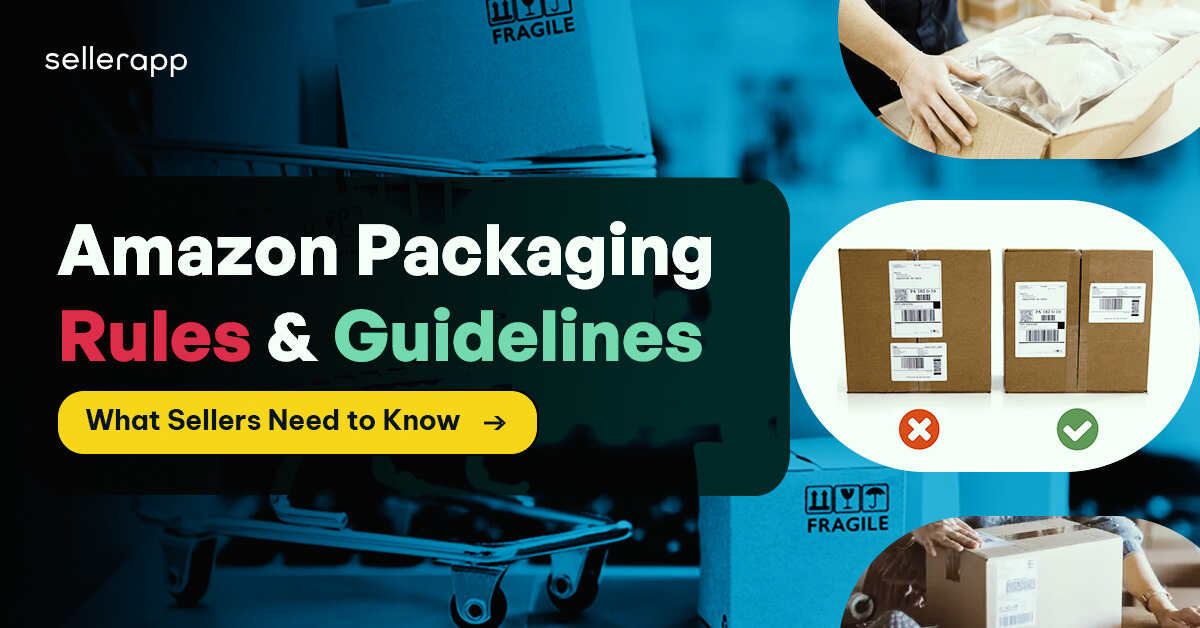Amazon Packaging Rules and Guidelines: What Sellers Need to Know

Amazon FBA makes fulfillment and distribution simple.
All you have to do? Get your inventory to the warehouses, and Amazon will take care of the rest.
Now, whilst the program is designed to make your life as easy as possible, you must still meet certain criteria when packaging your products for Amazon FBA.
In this guide, we’ll discuss different Amazon packaging requirements to help make your inventory process smoother.
In this guide:
- Amazon FBA Packaging: Why It Matters
- FBA Product Barcode Requirements
- General Packaging Requirements
- FBA Inbound Shipping Requirements
- Frequently Asked Questions
- Final Thoughts
Amazon FBA Packaging: Why It Matters
You may wonder why packaging even matters if Amazon will store and ship your products anyway.
Unfortunately for sellers, it’s not just a question of packing your items into any box you have and sending them off to Amazon.
Amazon has some specific packaging requirements for FBA sellers that may seem onerous at first but make sense when you consider the following:
- Poorly packaged goods can get damaged in transit.
- Poorly labeled goods may get lost or mixed up.
- Over-packaged goods are wasteful and damaging to the environment.
- Poor packaging could negatively impact the reputation of your business.
Amazon takes its packaging requirements seriously, and there are penalties for suppliers who fail to comply.
For example, Amazon may dispose of your inventory and block future shipments to its fulfillment centers – not good for business! Improperly labeled products may be marked as unsellable, and you might get slapped with a non-compliance fee.
But don’t worry, it’s all avoidable if you follow the rules.
Amazon FBA Product Barcode Requirements
Every item sent to an Amazon fulfillment center requires a barcode for identification and tracking throughout the fulfillment process.
Here are three types of barcodes used for product identification:
Manufacturer Barcodes:
- Each product item or variation (like size or color) must have a scannable barcode. This is usually the manufacturer barcode (UPC, EAN, JAN, ISBN) unless the barcode setting is changed or the product is not eligible.
- In cases where multiple sellers have inventory with the same manufacturer barcode, Amazon may fulfill orders with the inventory closest to the customer for expedited delivery.
Amazon Barcodes:
- All products not eligible for virtual tracking with the manufacturer barcode must have an Amazon barcode, also known as FNSKU.
- These barcode (FNSKU) labels start with an “X” followed by a unique combination of letters and numbers specific to the product.
- Products requiring additional packaging, such as bagging or bubble wrap, can be tracked by either the manufacturer’s barcode or Amazon’s barcode, but prepped items will need additional labeling.
- Upon arrival at Amazon fulfillment centers, barcodes must be scannable and not covered by packaging or other labels.
- Brand owners can apply for a GTIN exemption if their brand is approved for the Amazon Brand Registry and lacks a manufacturer barcode.
- Manufacturers or brand owners wanting to print barcodes directly on product packaging can apply for a GS1 standard UPC barcode.
Transparency Authenticity Codes:
- If you’re the brand owner, you may also use unique Transparency barcodes provided by Amazon to help prevent counterfeiting. Transparency codes have a distinct “T” logo.
- Products enrolled in the Transparency program are generally eligible for virtual tracking, with certain exceptions for specific categories.
Following Amazon’s barcode requirements ensures your products can be properly tracked and processed once they arrive for FBA.
General Packaging Requirements
In addition to barcodes, Amazon has general packaging requirements for FBA products. Here are a few of them:
Basic Requirements
Every product shipped to Amazon’s fulfillment centers must be contained within secure packaging. This means any loose or individual items, such as books, cosmetics, or electronics, must be in a box, bag, or other container.
Additionally, any existing barcodes on the exterior of shipping boxes must be removed or covered up. This prevents Amazon’s system from accidentally scanning the wrong barcode during receiving. Any FNSKU labels sellers create must have unique barcodes that match the specific product variation.
Sets & Multi-Piece Items
Extra steps must be taken if a product is sold as a set or has multiple pieces comprising one unit. Each set must be clearly labeled as not to be separated, such as “Sold as set” or “Ready to ship.” This ensures the pieces are kept together.
Multi-piece products that require assembly, such as furniture, are not accepted by Amazon. All units must be packaged and ready to ship to customers.
Box Requirements
Any boxed items must meet specific standards:
- Boxes must have six closed sides and adequately protect the contents. Boxes that collapse easily under pressure are prohibited.
- Box openings and lids must not easily open on their own. Tape or glue can be used to secure lids shut during shipping.
- If the box has perforated sides or openings, it must pass a 3-foot drop test on all sides without the contents breaking.
- For boxes over 10 lbs, double-walled corrugated cardboard often referred to as a corrugated box, is recommended for added durability.
Bubble Wrap & Poly Bags
Individual products can be wrapped in bubble wrap or sealed in plastic bags to provide extra protection. However, some guidelines apply:
- Bubble-wrapped items should be tightly wrapped and able to withstand drops without damage.
- Poly bags must meet minimum thickness standards and be fully sealed. Suffocation warning labels are required on large bags.
- Barcodes must remain clearly scannable through poly bags or be attached to the exterior.
Overboxing
For extra large or heavy items, Amazon may require “overboxing” – placing a product in an additional exterior box. This also applies to exceptionally fragile items that don’t pass drop tests. Overboxes must use sturdy double-walled cardboard for heavy products exceeding 10 lbs.
Mattresses
Any mattresses shipped to Amazon must be in corrugated cardboard boxes sized to fit.
Be sure to classify mattresses appropriately when creating new product listings. Mattresses should be categorized under “Mattresses” in Home & Kitchen.
Case Packed Items
When sending case-packed products, where a manufacturer packs multiple units together, some extra steps must be taken:
- All units in the case must be identical regarding SKU and condition. Mixing is not allowed.
- Quantities per case must be consistent across all cases. For example, if there are 24 packs, all cases must contain 24.
- Amazon limits case packs to 150 units. Larger wholesale boxes must be broken down into standard case packs.
- Any barcodes on the exterior of case packs must be covered or removed so that only the inner SKUs are scanned.
Expiration Dates
If products have expiration or best-by dates, the dates must use the MM-DD-YYYY or MM-YYYY format. Any variations must have a label in the proper format applied over the original date.
Expiration dates must be visible on the exterior packaging for products requiring additional prep, like poly bags or bubble wrap, to identify them on intake.
Restricted Products
Remember that Amazon prohibits certain highly flammable, hazardous, or perishable products from being stored in their fulfillment centers. Be sure to consult Amazon’s restricted products list before shipping large quantities.
Amazon FBA Inbound Shipping Requirements
When you are ready with all your packages and ready to ship them to Amazon, here are a few inbound shipping requirements you must follow.
When shipping FBA inventory, the first step is to give detailed box content information.
When creating a shipment in Seller Central, you must indicate precisely what items are in each shipping box and product quantities.
It helps Amazon correctly receive your inventory into their system and enables proper storage and management of stock within their fulfillment centers.
Also read: Strategies to Minimize Amazon FBA Inbound Placement Fees
Packaging Shipments Properly
How you package FBA shipments is crucial for safe transit to Amazon’s facilities.
- All boxes must be in good condition with intact flaps and a minimum of 6 x 4 x 1-inch dimensions.
- Reused boxes should have old labels, markings, and tape removed. Boxes should be sealed completely on all seams and edges with 2-3 inch wide tape with no gaps.
- Packing tape should bond tightly to surfaces.
- Inside each box, individually wrap and cushion products with materials like bubble wrap and paper to prevent damage from shifting.
- Allow at least 2 inches of cushioning between box contents and interior walls.
Box Dimensions and Weight
- Use acceptable standard boxes with dimensions measuring at least 6 x 4 x 1 inches.
- Boxes must not exceed 25.00 inches on any side and 50.00 lb total weight, except for individual oversize items.
- Follow specific requirements for oversized items, including weight restrictions and labeling for heavy packages.
- Avoid using point-of-sale containers, open display boxes, pallet-sized (“gaylords”), string, straps, or over-wrap.
Packing Materials
Amazon provides guidelines for acceptable and prohibited packing materials. Utilizing the right kind of packing materials to protect your inventory from damage:
Acceptable cushioning products:
- Bubble wrap,
- Kraft paper,
- Air pillows,
- Polyethylene foam sheets.
Prohibited materials:
- Packing peanuts,
- Foam pieces,
- Shredded paper,
- Thermocol chips and any type of styrofoam.
Additional Requirements:
- Scannable barcodes are mandatory for all products, adhering to FBA product barcode requirements.
- Each box requires an Amazon FBA Box ID label and carrier labels.
- Special requirements apply for different shipping methods, including LTL, FTL, and FCL deliveries.
- Compliance is crucial to avoid refusing inventory, disposing or returning goods, and blocking future shipments.
Frequently Asked Questions
Listed below are a few questions that FBA sellers usually ask:
How do I pack items for Amazon FBA?
Carefully follow Amazon’s category-specific guidelines for packing and prepping items based on whether they are individually sold, bundled/kitted, or case packed. Use any required specialized packaging for hazardous, liquid, or restricted products. Improperly packaged items may be rejected or damaged. Bubble wrap fragile items and bag others as needed.
How do I use Amazon packaging?
Select box sizes and materials that meet Amazon’s requirements for your specific products. Ensure boxes are new, sturdy, and properly sealed. Label boxes on all sides with FNSKU or other barcodes according to specifications. Use warning labels for restricted items. Place inserts, padding, and packing slips as required. Polybags must meet thickness standards with suffocation labels if needed.
What type of packaging does Amazon FBA use?
Amazon offers free branded packaging like boxes, polybags, bubble wrap, tape, labels, and more. You can also supply your own packaging if it meets the requirements. Consider Amazon’s prep and packaging rules for your product category when selecting materials. Improper packaging leads to damaged and rejected inventory.
Can I use any box to ship to Amazon FBA?
No. Only use new, sturdy, corrugated cardboard boxes free of markings and defects. Boxes must have 200 lbs bursting test strength and withstand drops. Follow exact sizing guidelines. Reused, flimsy, or non-compliant boxes may be rejected upon receipt. Using proper boxes reduces damage.
What size are Amazon FBA boxes?
Box sizes range from small (.38 cubic feet) to extra-large (25 cubic feet). Dimension must be at least 6″x4″x1″ but not exceed 25″ on any one side or 50 lbs. Box size depends on your products – don’t use oversized boxes with wasted space. Oversized individual items have separate guidelines. Standard sizes streamline storage.
What labels do I need for Amazon FBA?
Products need scannable FNSKU or manufacturer barcodes, plus a box ID barcode label on each shipment box. No special characters are allowed on labels. Follow exact label placement specs. Label each piece in multi-item sets. Transparency codes help prevent counterfeits for some brands. Accurate labeling enables tracking.
Does Amazon provide packing material?
Yes, Amazon provides a range of packaging materials for sale or free if using their carrier services. Options include boxes, polybags, bubble wrap, air pillows, tape, and more. Materials must protect items from damage during shipping. Using proper supplies reduces costs from damages.
How do I use Amazon FBA poly bags?
Polybags must be transparent, at least 1.5 mils thick, sealed with no openings, and have suffocation warning labels if used for packaging that could pose a risk. FNSKU barcodes must scan through bags. Follow category-specific bagging requirements. Use polybags appropriately to protect items.
What can we use instead of poly bags?
Alternatives like paper or cornstarch mailers, cardboard envelopes, or compostable bubble mailers. However, they must still meet Amazon’s size, labeling, sealing, and scanning requirements. Check if sustainable options are allowed for your product before using it. Proper packaging is necessary regardless of the material.
Final Thoughts
Follow Amazon’s packaging, prep, and shipping guidance to ensure your products make it to the fulfillment center intact and ready for efficient storage, order processing, and shipping.
Invest some time upfront in packaging and labeling prep. It will go a long way to minimize damages, quick delivery, and reduce delays in getting your inventory to the Amazon fulfillment center.
You can also partner with solutions like SellerApp to optimize your FBA business further.
SellerApp provides industry-leading 360° marketplace analytics to streamline your Amazon business from initial product research to full-scale sales.
Their platform provides insights you need to efficiently list items, monitor sales, understand customers, identify trends, boost advertising performance, and make data-driven decisions at every stage of your business.
The future of e-commerce is data-driven – be prepared to thrive with SellerApp.











Clare Thomas
May 24, 2024Thank you!
Anna Blair
April 10, 2024Enjoyed reading the article above , really explains everything in detail, the article is very interesting and effective. Thank you and good luck in the upcoming articles.
Clare Thomas
May 24, 2024Thank you for your valuable feedback.